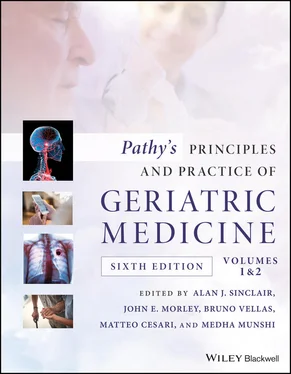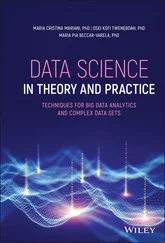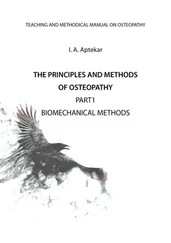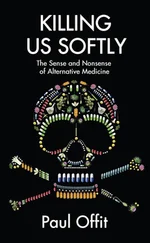Pathy's Principles and Practice of Geriatric Medicine
Здесь есть возможность читать онлайн «Pathy's Principles and Practice of Geriatric Medicine» — ознакомительный отрывок электронной книги совершенно бесплатно, а после прочтения отрывка купить полную версию. В некоторых случаях можно слушать аудио, скачать через торрент в формате fb2 и присутствует краткое содержание. Жанр: unrecognised, на английском языке. Описание произведения, (предисловие) а так же отзывы посетителей доступны на портале библиотеки ЛибКат.
- Название:Pathy's Principles and Practice of Geriatric Medicine
- Автор:
- Жанр:
- Год:неизвестен
- ISBN:нет данных
- Рейтинг книги:3 / 5. Голосов: 1
-
Избранное:Добавить в избранное
- Отзывы:
-
Ваша оценка:
- 60
- 1
- 2
- 3
- 4
- 5
Pathy's Principles and Practice of Geriatric Medicine: краткое содержание, описание и аннотация
Предлагаем к чтению аннотацию, описание, краткое содержание или предисловие (зависит от того, что написал сам автор книги «Pathy's Principles and Practice of Geriatric Medicine»). Если вы не нашли необходимую информацию о книге — напишите в комментариях, мы постараемся отыскать её.
Pathy’s Principles and Practice of Geriatric Medicine
Pathy's Principles and Practice of Geriatric Medicine — читать онлайн ознакомительный отрывок
Ниже представлен текст книги, разбитый по страницам. Система сохранения места последней прочитанной страницы, позволяет с удобством читать онлайн бесплатно книгу «Pathy's Principles and Practice of Geriatric Medicine», без необходимости каждый раз заново искать на чём Вы остановились. Поставьте закладку, и сможете в любой момент перейти на страницу, на которой закончили чтение.
Интервал:
Закладка:
3 Volume II Dedication Page Title Page Copyright Page About the Editors About the Associate Editors List of Contributors Preface to the Fifth Edition Preface to the Sixth Edition Foreword SECTION 7: Dementia and Cognitive Disorders CHAPTER 61: Delirium in older patients Introduction Rates of delirium Consequences of delirium Delirium phenotypes Pathophysiology Predisposing and precipitating factors Delirium identification: screening versus diagnosing Pharmacologic prevention of delirium Management of delirium Conclusion References CHAPTER 62: Memory clinics Introduction Developments around the world Why the need? Are they effective? The memory clinic team What happens in a memory clinic? What interventions can be offered? Summary References CHAPTER 63: Alzheimer’s disease Introduction Epidemiology of Alzheimer’s disease Risk factors of Alzheimer’s disease Neuropathology of Alzheimer’s disease What is the chronological relationship between amyloid deposits and neurofibrillary degeneration? Definition of the stages of cognitive severity Process for the diagnosis of Alzheimer’s disease Biomarkers of AD Treatment Toward a new paradigm: the prevention of Alzheimer’s disease Conclusion References CHAPTER 64: Mild cognitive impairment: an update Core clinical criteria for the diagnosis of MCI MCI research criteria incorporating biomarkers Conclusion: clinical acceptance of MCI References CHAPTER 65: Vascular dementia Historical perspective and definitions Vascular cognitive impairment – current definitions General epidemiological issues Pathophysiology Clinical impact: cognitive and motor impairment Preventive (risk‐factor control) and curative therapies Conclusions References CHAPTER 66: Mental stimulation and dementia Introduction Cognitive (mental) interventions Supporting evidence Mechanisms Targets of intervention Implementing interventions Conclusions Acknowledgements References CHAPTER 67: Exercise and dementia Introduction Physical activity and the prevention of dementia in clinical research Physical activity and executive function Frailty, physical activity, and cognitive reserve Biological mechanisms of physical activity in preventing cognitive decline Clinical practical applications: physical activity and prevention of AD Physical activity in AD populations Practical clinical applications: physical activity for demented patients Conclusion References CHAPTER 68: Drug development and Alzheimer’s disease Introduction Impact on cholinergic deficit Anti‐amyloid therapies Drugs to target tau protein Neuroprotective agents Neurorestorative approaches Non‐pharmaceutical therapies Prevention and AD Conclusion References CHAPTER 69: Other dementias Introduction Vascular cognitive impairment/vascular dementia Lewy body disease Dementia with Lewy bodies Parkinson’s disease with dementia Progressive supranuclear palsy Corticobasal degeneration Multiple system atrophy Frontotemporal lobar degeneration Depression Medications Dementia with parkinsonism Conclusion References CHAPTER 70: Management of neuropsychiatric symptoms in dementia Introduction Epidemiology Outcomes of NPSs Measurement of NFS Aetiology of NPSs Management of NPSs The DICE approach Perspectives and future directions References CHAPTER 71: Late‐life depression Introduction Definitions and concepts of depression Classifying diagnosis of depression in old age Clinical presentation of depression in older people Diagnosis and risk factors Impact Treatment Conclusion References CHAPTER 72: Geriatric psychiatry Introduction Epidemiology Challenges in geriatric psychiatry The psychiatric interview of an older adult Workup Interdisciplinary approach and individualised care plan Successful ageing Depression Bereavement Severe mental illness Cognitive disorders Substance use disorder (SUD) Anxiety disorders Sleep disorder Medication‐induced mental health problems Special populations in geriatric psychiatry End‐of‐life and palliative care Rational deprescribing Electroconvulsive therapy Transcranial magnetic stimulation therapy (TMS) Psychotherapy and other psychosocial interventions ATMAN approach to managing chronic non‐cancer pain Requests for physician‐assisted dying Spirituality and mental health Prevention in geriatric psychiatry Best‐practice models for geriatric psychiatry services Geriatric psychiatry in primary care offices Geriatric emergency department and psychiatric emergencies References CHAPTER 73: Organisation of services in geriatric psychiatry Introduction The ageism saga continues Developments in the UK 2000–2019 Wider societal changes Services Primary care Secondary care Bed‐based care, hospital‐based facilities, and acute in‐patient beds Interface services Patient and carer involvement References CHAPTER 74: The older patient with Down syndrome Introduction Genes and Down syndrome The physician, and the patient with Down syndrome Disorders associated with Down syndrome Conclusion References SECTION 8: Special Senses, Bone, and Joint Health CHAPTER 75: Disorders of the vestibular system Introduction Vestibular anatomy Physiology and ageing of the vestibular apparatus Clinical aspects and diagnostic strategy Peripheral vestibular disorders Central vestibular disorders Neurological conditions Management References CHAPTER 76: Smell and taste Introduction Olfaction Taste References CHAPTER 77: Osteoporosis: burden, diagnosis, and management Introduction Global epidemiology of fragility fractures and regional disparities Burden of osteoporosis The osteoporosis treatment gap Intervention and assessment thresholds Management Conclusion References CHAPTER 78: Gait, balance, and falls Introduction Balance Gait Age‐related changes Falls Appendix 78.1 Appendix 78.2 References CHAPTER 79: Hip fracture and orthogeriatrics Background Diagnosis and classification Preoperative care Fracture repair and perioperative care Secondary fracture prevention Fracture liaison service Orthogeriatric collaboration and orthogeriatric models References CHAPTER 80: Foot problems Introduction Epidemiology of foot problems in older people Clinical assessment of foot problems Management of foot problems in older people The role of footwear Conclusion References SECTION 9: Endocrine and Metabolic Disorders CHAPTER 81: Endocrinology of ageing Introduction The modern field of endocrinology Regulation of hormonal action General changes in regulation and action of major hormones of metabolism, reproduction, and growth with age Effects of ageing and related diseases on endocrine function Effects of common endocrine diseases on ageing The hormonal fountain of youth References CHAPTER 82: The pituitary gland Introduction Anatomy Blood supply Anterior pituitary disorders – clinical manifestations Anterior pituitary disorders – treatment References CHAPTER 83: Thyroid disorders Introduction Age‐related modifications in thyroid function Prevalence of thyroid disease in older populations Hypothyroidism Hyperthyroidism Nonthyroidal illness (NTI) Thyroid nodules and nodular goitre Conclusion References CHAPTER 84: Ovarian function and menopause Introduction The biological basis of menopause The impact of menopause Management of menopause References CHAPTER 85: Testicular function Introduction Decline in serum T with ageing Decline in spermatogenesis with ageing Diagnosis of hypogonadism in elderly men Laboratory diagnosis Treatment of late‐onset hypogonadism Conclusion and recommendations References CHAPTER 86: Diabetes mellitus Introduction Epidemiology, pathogenesis, and modes of presentation Diabetic foot disease Sexual function Metabolic comas Cognitive dysfunction Type 2 diabetes mellitus and depression Importance of functional evaluation Importance of detecting frailty Treatment and care issues: learning from the literature Inpatient diabetes care Prevalence of diabetes mellitus in care homes Prevention Impact of Covid‐19 on residents with diabetes in care homes Conclusion Appendix 86.1: A scheme for treating older adults with type 2 diabetes using a three‐step approach Note on insulin therapy in older adults Appendix 86.2: Individualised metabolic targets according to major international guidelines Appendix 86.3 Appendix 86.4: End‐of‐life diabetes care References CHAPTER 87: New therapies for diabetes mellitus Introduction Microvascular complications Macrovascular complications Lifestyle intervention Currently approved antiglycaemic therapies Basal insulin Bolus insulin Developing antiglycaemic classes and their characteristics Gut microbiota: a new potential target for the treatment of type 2 diabetes Conclusion References SECTION 10: Urogenital Disorders CHAPTER 88: Gynaecology and the older patient Introduction Effect of ageing on the genital tract Postmenopausal bleeding Pelvic ultrasound scan Discharge per vagina Uterovaginal prolapse Urinary incontinence Sexuality and ageing Vulval disorders Hormonal changes with ageing and menopause Nonhormonal treatment Gynaecological cancer HIV in old age Conclusion References CHAPTER 89: Prostate diseases Introduction Benign prostatic hyperplasia Prostate cancer Prostatitis References CHAPTER 90: The ageing bladder Introduction Anatomy of the ageing bladder Bladder physiology and correlation to the anatomy of the ageing bladder Special disease states Pharmacology as it relates to the ageing bladder Surgical disease of the ageing bladder Conclusion References CHAPTER 91: Geriatric nephrology Introduction Normal ageing: glomerular level Diseases: at the glomerular level Normal ageing: renovascular level Diseases: reno‐vascular level Normal ageing: tubular‐interstitial level Diseases: tubular‐interstitial level Acute kidney injury (AKI) Chronic kidney disease (CKD) Renal pharmacology References SECTION 11: Cancer CHAPTER 92: Cancer and ageing Introduction Epidemiology and disparities Ageing and tumour development Cancer prevention Cancer treatment Survivorship Conclusion References CHAPTER 93: Oncological emergencies Introduction Haematological emergencies Metabolic emergencies Cardiovascular emergencies Neurological emergencies Structural emergencies Acute pain emergencies The role of geriatric evaluation in the prediction of oncological emergencies Conclusion References CHAPTER 94: Breast cancer The presentation Stage of presentation Variation in care and undertreatment in the elderly Screening in the elderly Risk factors in the elderly Natural history of breast cancer in the elderly Treatment of operable disease Prognostic factors in elderly breast cancer Quality of life issues Conclusion Guidelines for therapy References CHAPTER 95: Maintaining functional status among older adult cancer patients and survivors Introduction A role for geriatricians in cancer care Use structured methods to establish decisional capacity prior to treatment Geriatric management during cancer treatment Exercise Conclusion References SECTION 12: Functional Disorders and Rehabilitation CHAPTER 96: Multidimensional geriatric assessment Introduction Definition Rationale Brief history of geriatric assessment Components of geriatric assessment Settings of geriatric assessment Effectiveness of geriatric assessment programmes Conclusion References CHAPTER 97: Frailty Introduction Pathophysiology of frailty Disease Conclusion References CHAPTER 98: Rehabilitation Introduction Terminology and classifications Determinants of activity and participation restrictions Psychological aspects of rehabilitation Principles of rehabilitation Emerging technologies and rehabilitation Specific rehabilitation problems Future challenges References CHAPTER 99: Cachexia Introduction Consequences of cachexia Pathophysiology of cachexia Treatment of cachexia References CHAPTER 100: WHO Integrated Care for Older People (ICOPE) Introduction ICOPE steps ICOPE implementation Expected outcome moving forward References SECTION 13: Iatrogenic Infections CHAPTER 101: Valvular heart disease and infective endocarditis Introduction Epidemiology and prevalence of valvular heart disease in the ageing population Aetiology of valvular heart disease History and physical exam Investigations Aortic stenosis Aortic regurgitation Mitral stenosis Mitral regurgitation Tricuspid regurgitation Tricuspid stenosis and pulmonic valve disease Mixed valve disease Management of patients following valve interventions Infective endocarditis Conclusion Key references Further reading CHAPTER 102: Infections of the central nervous system Introduction Meningitis Focal central nervous system infections References SECTION 14: Special Issues SECTION I: Abuse and Older People CHAPTER 103: Good quality care: abuse Ageism Psychological control Abuse Good treatment Ethics Prevention Inclusive society Conclusion Bibliography CHAPTER 104: Alcohol consumption and cognition Evidence from studies Prospective evidence Alcohol consumption and Alzheimer’s disease What is the cognitive and brain atrophy pattern in heavy drinkers? Conclusion References CHAPTER 105: The use and abuse of prescribed medicines Introduction Use and harmful use Pharmacology Prevalence and correlates Benzodiazepines Illicit drug misuse Treatment Prognosis Conclusion References CHAPTER 106: Drug misuse and the older person: a contradiction in terms? Introduction Medications and the older people: geriatric specificities, adverse drug reactions, and drug misuse References SECTION II: Emerging Themes CHAPTER 107: Transportation, driving, and older adults Introduction Illness and transportation What do we need to know to assess our older patients? Conclusion References CHAPTER 108: Smart Homes Introduction Definition of a Smart Home Healthcare‐enabled Smart Homes Ubiquitous Homes The elderly as technology users Example: healthcare‐enabled Smart Home for an aged resident Challenges Conclusions References CHAPTER 109: Modern use of biomarkers in geriatric medicine Introduction Comprehensive geriatric assessment Dementia Frailty Sarcopenia Intrinsic capacity Concluding remarks References SECTION III: Dermatology CHAPTER 110: Geriatric dermatology Introduction Inflammatory dermatoses Infectious dermatoses Neoplastic dermatology Conclusion References CHAPTER 111: Pressure injuries Clinical staging of pressure injuries Measuring pressure injury healing Risk factors Risk assessment Prevention of pressure injuries Treatment of pressure injuries Diagnosing infection in chronic wounds Non‐healable pressure injuries and skin failure References SECTION IV: Surgical Themes CHAPTER 112: Perioperative medical assessment of older adults Shifting demographics create more need Physiology of ageing and frailty Essentials of preoperative assessment Framework for organizing complexities What matters most Postoperative management Care after the hospital Conclusion References CHAPTER 113: Anaesthesia Introduction Outcome of surgery and anaesthesia in the elderly Cardiovascular morbidity associated with surgery and anaesthesia Respiratory morbidity associated with surgery and anaesthesia Central nervous system morbidity associated with surgery and anaesthesia Postoperative confusion Postoperative stroke Renal morbidity associated with surgery and anaesthesia Perioperative hypothermia Preoperative assessment Pain assessment and management in the elderly Ethical considerations for perioperative care of the elderly Strategy to reduce postoperative morbidity and mortality in the elderly Conclusion References SECTION V: Ageing Themes and Ethical Issues CHAPTER 114: Health issues in the ageing woman Cancer Menopause Acknowledgements References CHAPTER 115: Antiageing strategies Introduction The demographic revolution What is antiageing medicine? Can death be delayed? Can the course of disability and functional dependence be reversed? Can disability and functional dependence be delayed? Mechanisms and evidence from biogerontological research Ethical issues Conclusion References CHAPTER 116: The ethics of geriatric care Introduction Ageism and geriatric care Ethics and the geriatric patient Longevity, healthspan, and health promotion Conclusion References CHAPTER 117: Participation of older people in clinical trials Introduction Temporal trends in the inclusion of older people in clinical trials Determinants of participation of older people in clinical trials Facilitating the access of older people to clinical trials Conclusion References CHAPTER 118: Restraints and immobility Introduction Immobility Physical restraints Siderails Risk factors and justification Complications Outcomes of restrictive device reduction Approaches to reduce restrictive device usage Conclusion References CHAPTER 119: Centenarians Demography of centenarians: past, present, and forecasts Sex differences and the paradox of centenarians An optimistic view Compression of morbidity versus disability Heredity (nature) versus environment (nurture) Omics technologies in centenarian studies Conclusion References SECTION VI: End‐of‐life Care CHAPTER 120: End‐of‐life and palliative care Introduction to palliative care Hospice care Communication Prognostication Symptom assessment and treatment Psychosocial and spiritual domains Cross‐cultural issues Care transitions in end‐of‐life care References CHAPTER 121: End‐of‐life care: special issues Introduction The benefits of a palliative approach When to involve SPCTs Withholding and withdrawing treatment Care planning End‐of‐life and terminal care Bereavement Conclusion References PART 3: Global Healthcare Systems CHAPTER 122: Improving quality of care Introduction The history of quality Organisations leading healthcare quality improvement Quality improvement in geriatrics Healthcare financing drives quality Integrated care and population health Healthcare accreditation Quality in geriatrics hospital care Quality in the community setting Health outcomes research Clinical practice guidelines Healthcare audits as a QAPI process Future initiatives in healthcare quality Conclusion References CHAPTER 123: Clinical audit of healthcare Introduction History of clinical audits Clinical audit versus quality improvement Local versus national audit Why do a clinical audit? Designing and completing an audit Determining standards Defining terms Sampling Consent and confidentiality Piloting Data analysis Identifying the cause of problems Disseminating results and creating change Re‐auditing and sustaining improvement Audit as a driver for change Big data Patient and user input: codesign Audits in relation to older people Conclusion References CHAPTER 124: Caring for the caregiver Impact of caregiving on the caregiver and the family Distinctions between paid and unpaid caregivers Aspects of caregiving Assessments for caregivers Strategies for coping and improved well‐being Cultural diversity in caregiving Topics to address with caregivers Roles of healthcare providers in assisting caregivers Discussion References CHAPTER 125: Nursing home care Introduction Societal role and governance of nursing homes Facility demographics Quality Intersection between nursing homes and the law End‐of‐life care in nursing homes Challenges of research and cross‐country comparisons Gaps, best practices, and innovations Discussion – future directions References CHAPTER 126: Geriatric occupational therapy: achieving quality in daily living Overview Scope of occupational therapy services Occupational therapy process Intervention Outcomes (engagement in activity to support participation) Conclusion References CHAPTER 127: Geriatric medicine education in Europe and the United States Introduction Geriatric education in Europe Geriatrics education in the United States of America Conclusion References CHAPTER 128: Systems of healthcare: the United States Introduction Overview of healthcare demographics Development of geriatric medicine Home healthcare Post‐acute and long‐term care Assisted living Hospital care Stroke centres Academic geriatrics Conclusion References CHAPTER 129: Systems of healthcare: Australia Overview of healthcare demographics Healthcare services in Australia Academic geriatric medicine Conclusion References CHAPTER 130: Systems of healthcare: the UK Introduction Overview of healthcare demographics Development of geriatric medicine Home healthcare Care homes Hospital care Academic geriatrics and geriatric training References CHAPTER 131: Geriatric medicine in China Introduction Service provision Training Research Conclusion References CHAPTER 132: Ageing in developing countries Introduction Demography Heterogeneity in the ageing population in LAMICS Socioeconomic differences in adult mortality and health status Ageing and health Evolution of life expectancy Evolution of healthy life expectancy Dementia and cognitive impairment Multimorbidity Frailty Healthcare and geriatric medicine References CHAPTER 133: Geriatric medicine in the European Union: towards unification of diversity Introduction Demography: an ageing society Epidemiology: health and function Organisation of the European Union Healthcare systems in Europe Geriatric medicine across Europe Geriatric organisations in Europe Recent developments in EU policy References CHAPTER 134: Research horizons for the twenty‐first century Introduction Ageing research models Research in humans Setting priorities for research on ageing Conclusions References Appendix Function assessment scales Dental Hallpike Manoeuvre Osler Manoeuvre for pseudohypertension The Mini‐Nutritional Assessment (MNA) Scale The Confusion Assessment Method (CAM) diagnostic algorithm
Читать дальшеИнтервал:
Закладка:
Похожие книги на «Pathy's Principles and Practice of Geriatric Medicine»
Представляем Вашему вниманию похожие книги на «Pathy's Principles and Practice of Geriatric Medicine» списком для выбора. Мы отобрали схожую по названию и смыслу литературу в надежде предоставить читателям больше вариантов отыскать новые, интересные, ещё непрочитанные произведения.
Обсуждение, отзывы о книге «Pathy's Principles and Practice of Geriatric Medicine» и просто собственные мнения читателей. Оставьте ваши комментарии, напишите, что Вы думаете о произведении, его смысле или главных героях. Укажите что конкретно понравилось, а что нет, и почему Вы так считаете.












